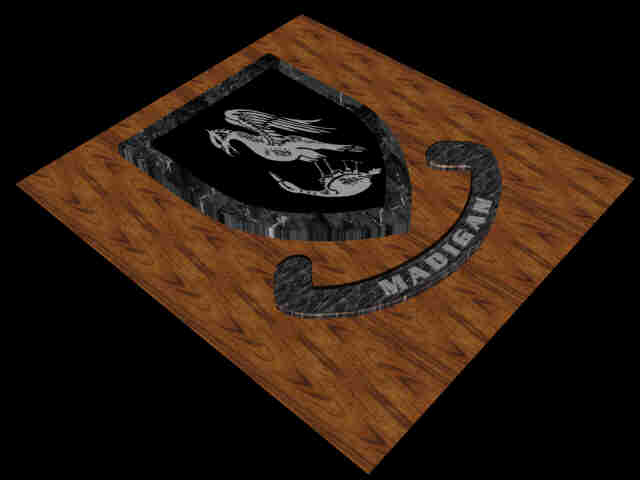The second adventure in Seward was to the
Alaska Sea Life Museum. If there is anything you ever wanted to know about the
Alaskan waters, you can find it there. The Museum actually has three missions:
one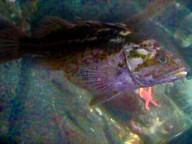 is research, one is animal rehabilitation and a final is education. It was here
that I got to see all those wonderful creatures I had been eating for the last
month or so. The center of attraction for this building is the extremely large
fish tanks with some of them having a walkway around the top so that you can see
the various creatures that swim on top. One aquarium is also an estuary
containing a lot of the shoreline birds that swim better than they fly. Of
course my favorite shoreline flyer was present with all its color. The tufted
puffin's large, triangular beak sits it apart from other seabirds. While alcids
like murres eat only soft foods, fishes and small shrimps, puffins can use their
powerful beaks to crush sea urchins and clams as well. During breeding season, a
puffin's beak gets even larger and more colorful. They use their beaks in
special moves to court and win their mates. During the summer breeding season,
adult Tufted Puffins are easy to identify with their white faces and unique
tufts behind each eye. They nest in deep burrows that they dig on rocky coastal
cliffs and islands. They can collect and hold many fish in their bills to bring
back to their young in the nest. Though they feed their chicks mostly fish, the
adults also feed on squid, shrimp, crabs and krill. In winter, Tufted Puffins
spend months alone or in pairs far offshore on the open North Pacific Ocean. The
next tank I visited contained Steller sea lions who spend most of the year at
sea, but in May come ashore on crowded breeding islands. Males arrive first and
stake out territories. When the females arrive, they give birth and mate. They
nurse their pups, leaving to feed from time to time, and then head back to sea
with the pups by the end of summer. The islands are crowded, and are loud with
the sounds of the sea lions. Large breeding males
is research, one is animal rehabilitation and a final is education. It was here
that I got to see all those wonderful creatures I had been eating for the last
month or so. The center of attraction for this building is the extremely large
fish tanks with some of them having a walkway around the top so that you can see
the various creatures that swim on top. One aquarium is also an estuary
containing a lot of the shoreline birds that swim better than they fly. Of
course my favorite shoreline flyer was present with all its color. The tufted
puffin's large, triangular beak sits it apart from other seabirds. While alcids
like murres eat only soft foods, fishes and small shrimps, puffins can use their
powerful beaks to crush sea urchins and clams as well. During breeding season, a
puffin's beak gets even larger and more colorful. They use their beaks in
special moves to court and win their mates. During the summer breeding season,
adult Tufted Puffins are easy to identify with their white faces and unique
tufts behind each eye. They nest in deep burrows that they dig on rocky coastal
cliffs and islands. They can collect and hold many fish in their bills to bring
back to their young in the nest. Though they feed their chicks mostly fish, the
adults also feed on squid, shrimp, crabs and krill. In winter, Tufted Puffins
spend months alone or in pairs far offshore on the open North Pacific Ocean. The
next tank I visited contained Steller sea lions who spend most of the year at
sea, but in May come ashore on crowded breeding islands. Males arrive first and
stake out territories. When the females arrive, they give birth and mate. They
nurse their pups, leaving to feed from time to time, and then head back to sea
with the pups by the end of summer. The islands are crowded, and are loud with
the sounds of the sea lions. Large breeding males 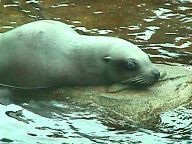 defend their territories, roaring and fighting. Females interact noisily with
each other and their pups, and wander about the island returning often to the
sea to eat. The males stay put, guarding their territories the entire season. Then
there was my favorite west coast eating fish, Pacific Halibut (Hippoglossus
stenolepis). This is the largest flatfish in the area, ranging from the Sea of
Japan to Bering Sea and south to Santa Rosa Island in southern California. They
are often migratory. Young halibut live near shore, but adults range in depths
of about 3600 feet. Halibut are fished both commercially and for sport. Look for
a triangular dorsal fin to distinguish halibut from rock sole. In yet another
tank we found the always loveable and playful seals. Seals live close to shore:
you'll see them basking on beaches, low rocks and on ice near tidewater
glaciers. Sometimes they rest alone, other times in groups of up to 500. Harbor
seals are used to living near people, but they're still wary. They come ashore
in places
defend their territories, roaring and fighting. Females interact noisily with
each other and their pups, and wander about the island returning often to the
sea to eat. The males stay put, guarding their territories the entire season. Then
there was my favorite west coast eating fish, Pacific Halibut (Hippoglossus
stenolepis). This is the largest flatfish in the area, ranging from the Sea of
Japan to Bering Sea and south to Santa Rosa Island in southern California. They
are often migratory. Young halibut live near shore, but adults range in depths
of about 3600 feet. Halibut are fished both commercially and for sport. Look for
a triangular dorsal fin to distinguish halibut from rock sole. In yet another
tank we found the always loveable and playful seals. Seals live close to shore:
you'll see them basking on beaches, low rocks and on ice near tidewater
glaciers. Sometimes they rest alone, other times in groups of up to 500. Harbor
seals are used to living near people, but they're still wary. They come ashore
in places 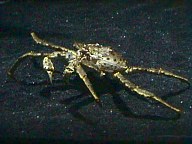 where they won't be disturbed, and they stay close to water so they can slip
quickly back to safety. They spend roughly half of their lives out of water.
They come ashore or "haul out" to rest and to warm up. (Swimming takes
a lot of energy, especially in cold water). Female seals give birth and nurse
their pups on land until the pups are ready to begin the onshore-offshore life
of an adult seal. While wandering around in the basement area I came across a
series of small tanks. One contained something I had only read about, the giant
deep-sea octopus. Octopuses are built to ooze between rocks. A rocky cave in
dark, cold water makes a perfect habitat and hiding place for the shy giant
octopus, which can wedge its soft body into surprisingly small crevices. At
night the octopus ventures out, hungry for crabs, clams, shrimp and even
sometimes an occasional fish. An expert predator, it is adept at camouflage. The
octopus stalks its prey then
where they won't be disturbed, and they stay close to water so they can slip
quickly back to safety. They spend roughly half of their lives out of water.
They come ashore or "haul out" to rest and to warm up. (Swimming takes
a lot of energy, especially in cold water). Female seals give birth and nurse
their pups on land until the pups are ready to begin the onshore-offshore life
of an adult seal. While wandering around in the basement area I came across a
series of small tanks. One contained something I had only read about, the giant
deep-sea octopus. Octopuses are built to ooze between rocks. A rocky cave in
dark, cold water makes a perfect habitat and hiding place for the shy giant
octopus, which can wedge its soft body into surprisingly small crevices. At
night the octopus ventures out, hungry for crabs, clams, shrimp and even
sometimes an occasional fish. An expert predator, it is adept at camouflage. The
octopus stalks its prey then 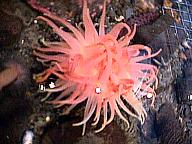 strikes, biting with a beak hidden in the center of its circle of arms. It will
then drag the prey back to the cave to dine. The last stop on our tour was the
touching pool. A place for children, filled with all sorts of living shellfish.
The attendant encouraged all to put their hands in the water and pet the
creatures lurking on the bottom. I selected a brightly colored Anemone. The
Crimson Anemone has long slender drooping tentacles that drape over the center
column and have interesting zigzag lines on them. With no skeleton, the body is
a can-shaped cylinder with an outer skin layer and an inner gut layer plus a
layer of incompressible jelly and muscles in the middle. Tentacles may be pulled
into the interior of the column for protection or during digestion. All in all
this was a good time. There were some old friends and some new acquaintances.
I'd put it on the "must see" list just for the hell o bit(:-).
strikes, biting with a beak hidden in the center of its circle of arms. It will
then drag the prey back to the cave to dine. The last stop on our tour was the
touching pool. A place for children, filled with all sorts of living shellfish.
The attendant encouraged all to put their hands in the water and pet the
creatures lurking on the bottom. I selected a brightly colored Anemone. The
Crimson Anemone has long slender drooping tentacles that drape over the center
column and have interesting zigzag lines on them. With no skeleton, the body is
a can-shaped cylinder with an outer skin layer and an inner gut layer plus a
layer of incompressible jelly and muscles in the middle. Tentacles may be pulled
into the interior of the column for protection or during digestion. All in all
this was a good time. There were some old friends and some new acquaintances.
I'd put it on the "must see" list just for the hell o bit(:-).
*** THE END ***

